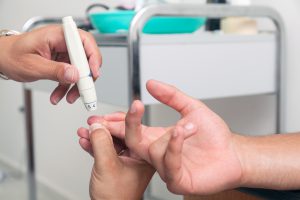 In 2014, the New Jersey State Board of Dentistry ruled that dentists in New Jersey could screen at-risk patients for diabetes, and although such in-office screening is within the scope of licensure in the state, this testing is not to be presumed to be the standard of care. This can be interpreted to mean that the screening needs to be followed by referral to a physician for definitive diagnosis. The glycated hemoglobin (HbA1c) screening can be performed as a finger stick and analyzed in the dental office. Patients visit their dental provider more frequently than their physician, so the impact of diabetes screening and referral of patients with positive test results to their physician for management will be felt immediately for the individual and the healthcare system as well. Early diagnosis is critical to the lifespan and healthspan of individuals with diabetes. Overall healthcare savings should be very significant especially in view of the seriousness of the rapidly expanding number of diabetic and prediabetic individuals in the U.S.
In 2014, the New Jersey State Board of Dentistry ruled that dentists in New Jersey could screen at-risk patients for diabetes, and although such in-office screening is within the scope of licensure in the state, this testing is not to be presumed to be the standard of care. This can be interpreted to mean that the screening needs to be followed by referral to a physician for definitive diagnosis. The glycated hemoglobin (HbA1c) screening can be performed as a finger stick and analyzed in the dental office. Patients visit their dental provider more frequently than their physician, so the impact of diabetes screening and referral of patients with positive test results to their physician for management will be felt immediately for the individual and the healthcare system as well. Early diagnosis is critical to the lifespan and healthspan of individuals with diabetes. Overall healthcare savings should be very significant especially in view of the seriousness of the rapidly expanding number of diabetic and prediabetic individuals in the U.S.
Elevated blood glucose levels will be detected anywhere the blood sample is obtained. While the NJ State Board of Dentistry stipulated that a finger stick is necessary, research has intriguingly shown that gingival bleeding upon probing can be a non-invasive source of a blood sample. One such study from 2016 tested 30 patients for evaluation of blood sugar levels from both a finger stick and gingival bleeding1. All 30 patients had blood sampled from both sites. The results demonstrated that mean glucose levels from gingival and finger stick blood did not differ either during fasting or postprandial testing.
Hopefully other state boards of dentistry will follow New Jersey’s lead and approve and encourage diabetes screening in the dental setting. The potential to impact the global diabetes epidemic with non-invasive blood sample collection would be a tremendous opportunity for dental professionals and their patients. This would be particularly true if salivary testing of glycemic levels becomes available. More on this to follow.
1- Shylaja MD, et al. Noninvasive Technique for Estimating Blood Glucose Levels among Diabetic Patients. J Contemp Dent Pract. 2016 Mar 1;17(3):248-52.
For more information on how to become an OralDNA Provider – scan HERE: 
- The Insights Provided by Salivary Testing - December 27, 2019
- I Don’t Need That, We’re Already Getting Good Results - November 29, 2019
- What’s Your Excuse? - August 30, 2019
